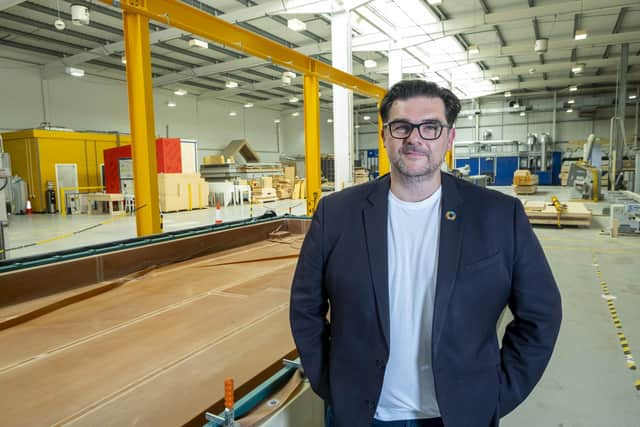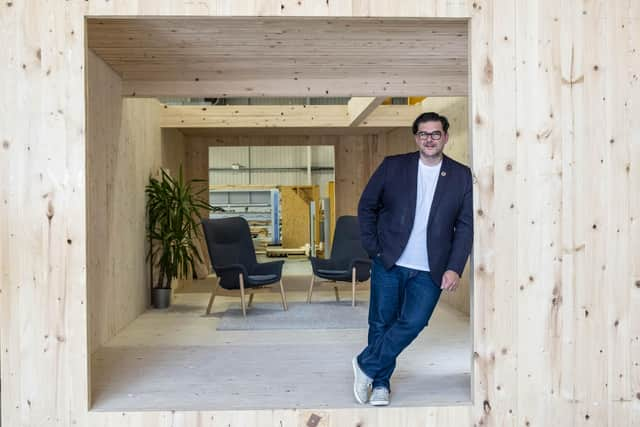The Big Interview: Stephen Good, CEO of the Construction Scotland Innovation Centre
Mr Good is charged with driving the organisation's vision and strategy as it aims to foster a better built environment that delivers inclusive and sustainable economic, social, and environmental impact, helping accelerate the transition to net zero.
The career of the trained architect – who spent a decade with Glasgow-based Anderson Bell + Christie – has spanned the sustainability consultancy, architectural design, offsite manufacturing, and construction-management sectors.
Advertisement
Hide AdAdvertisement
Hide AdRecent milestones by CSIC – which is based at its Innovation Factory at Hamilton International Technology Park – include launching its £450,000 Low Carbon Learning programme, billed as the UK’s first training course designed to equip workers in construction with the skills to retrofit buildings for a green future.


Can you explain more about the remit and aims of CSIC – and how your role fits with these?
CSIC’s core focus is supporting the entire Scottish construction and built environment ecosystem to transition to zero carbon, enabling organisations big and small to deliver meaningful and significant change. Our ambition is to really embed a culture of innovation that equips the industry with the tools, knowledge and skills needed to unlock new, valuable opportunities that are emerging alongside the green transition.
There are various ways we’re providing practical support – for example with access to funding or through our Hamilton-based innovation factory, where companies can build and test prototypes in a controlled environment, and which they can then go on to scale up.


We bring together supply chains and competitors to collaborate, and we offer access to skills and training support, world-class university expertise, and cutting-edge equipment to help organisations expand and diversify.
Another big part of our work is in helping the sector to attract and support the next generation of talent, along with developing the current workforce to embrace innovation, and ensuring we have the skills and competencies needed to achieve zero carbon.
As CEO, my role is to provide effective leadership and enable our team to support the industry in a way that will deliver the greatest impact. It’s my job to make sure our team has everything it needs to make our mission a reality, and foster the innovation mindset needed to supercharge this transition to zero carbon.
How was the centre’s work affected by the severe impact of the pandemic on the construction industry? You’ve cited a silver lining with a culture of innovation and collaboration in the built environment emerging…
Advertisement
Hide AdAdvertisement
Hide AdCSIC was already a flexible organisation, but there was some interim disruption for our innovation factory and some of the project work under way. Our events, skills and training programmes moved online quickly, and the team developed a new online portal to support that.
Early on, the centre was asked to support the wider industry’s efforts to restart and get the sector back up and running safely, and as quickly as possible. We helped businesses to implement safe, new ways of working, and did that at speed.
And given the challenges of lockdown, the sector’s appetite for innovation grew almost overnight, and we have seen collaboration like never before. We are now engaging with partners who are much more open to innovate and drive change, and transformation across the sector is a current reality, not an aspiration.
You recently hosted a webinar discussing the opportunities that COP26 presents industry to accelerate to zero carbon, deeming it a milestone event for Scotland. Can you expand on your views on this?
The climate emergency is now firmly at the top of the global agenda, and this is the most important COP there has been and likely will be. With the built environment responsible for around 47 per cent of UK carbon emissions the construction and built environment community has a major role to play.
COP26 will be an opportunity to showcase Scotland’s skills and expertise, and world-class innovation that is already delivering impact in the fight against climate change. From November 1 to 12 , CSIC’s innovation factory will become a hub for the built environment, with a range of forward-thinking, low-carbon exhibits, demonstrations and events.
There will be a host of opportunities for people to engage, learn and take inspiration from best-practice built-environment projects and the experts already accelerating Scotland’s journey to zero carbon.
There will be a wide range of commitments and action that we see the sector embracing in the months after COP26, and as part of that momentum, we are developing a focused programme of innovation support mechanisms and tools that the construction and built-environment community can engage with to help them transition to zero carbon.
Advertisement
Hide AdAdvertisement
Hide AdBritain’s construction sector has been facing a sharp increase in costs. How can the sector’s fortunes be improved, including at a Scottish level specifically?
Our work focuses on some of the more medium to long-term solutions needed to create a more resilient supply chain. Some things could change immediately, if clients, specifiers, and contractors had the appetite to switch to some of the locally manufactured and supplied solutions already available here in Scotland, but there are challenges around just how fast these could be scaled up.
We also need to think about it in the wider context of the climate emergency and what types of materials and low-carbon systems will be required to both build new, sustainable infrastructure and to retrofit our existing buildings. We need to create the market conditions where these can be made in Scotland, from Scotland, and maximise the opportunities to scale up our supply and our skills base in anticipation of this future demand.
CSIC offers skills training in areas such as digital transformation and culture change – how crucial is upskilling? And how can construction improve its gender balance, and diversity generally?
Upskilling is an essential part of creating a dynamic, flexible and future-proof workforce, but it goes hand in hand with reskilling and multi-skilling too. The digital transformation is starting to create a skills gap in construction that we must work together to close, both through new talent and by retraining the current workforce.
It’s frustrating that we haven’t seen greater progress in developing a workforce that is more balanced and diverse. There is no silver bullet, but diversity must be embedded within recruitment processes, company policies, and the culture across the entire sector.
You studied architecture – what attracted you to this subject, and how did your career then progress before your arrival at CSIC? What has been the most pivotal moment in your career so far?
My dad was always interested in architecture, and from a young age taught me to look up when visiting a new town or city to truly appreciate the built environment. I practiced as an architect for nearly ten years, primarily working on a range of housing-regeneration, healthcare, community and education projects, always with an interest in sustainability.
Advertisement
Hide AdAdvertisement
Hide AdIn 2007, I joined a construction organisation that was pioneering offsite manufacturing and was privileged to be part of the team that created one of the most advanced offsite projects at the time: the 2014 Commonwealth Games Athlete’s Village in Glasgow.
The focus we had on innovation opened up opportunities to engage with the wider industry and government, looking at ways to drive innovation and change across the sector. In 2014, having worked with a pan-industry and academic collaboration group to secure support for a construction innovation centre, I was invited to take on the role of CEO, and the past seven years have been spent building the team and the centre into a critical national asset for Scotland’s construction and built-environment ecosystem.
A pivotal moment was moving from the construction manufacturing space to my current role at CSIC, which gave me the opportunity to tangibly support transformation across the entire sector. However, I think the biggest moment is perhaps still ahead of us, as we become laser-focused on supporting Scotland’s built environment transition to zero carbon.
CSIC said in 2020 that it had supported 355 projects with total project value of £34.6 million. Are you able to reveal any targets going forward – and what would you like the legacy of your leadership of the centre to be?
While project values and targets are a crucial measure of our activity, we are primarily focused on tracking the impact of what we do. Over the next few years, we will be looking at three key measures: the economic impact for the sector, where we have a target to unlock more than £1 billion of additional value, the carbon savings we deliver as a result of our supported programmes, and the impact on jobs and talent, from creating new roles within existing businesses to supporting start-ups and spin-outs.
I’d like CSIC to be valued by the sector as an indispensable centre of excellence and a trusted partner with the tools, expertise and networks that can help unlock the innovation potential in their organisation and enable them find new ways of doing things as they transition to zero carbon.
A message from the Editor:
Thank you for reading this article. We're more reliant on your support than ever as the shift in consumer habits brought about by coronavirus impacts our advertisers.
If you haven't already, please consider supporting our trusted, fact-checked journalism by taking out a digital subscription.
Comments
Want to join the conversation? Please or to comment on this article.
